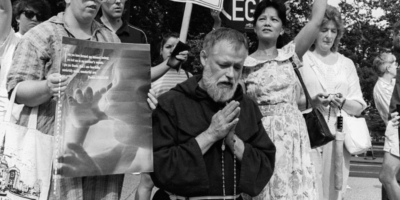What’s in a Bra? All of Jewish Women’s History, Perhaps
It all started for artist Stephanie Sakellaris with a dream of tefillin. They weren’t hard like the wooden boxes and leather straps men have traditionally worn, but soft, “like food,” she says. And when she awoke, “I saw my black bra there and knew what I had to do.”
What she had to do, it turned out, was to create tefillin, made of that black bra, sewed up, stuffed with rice and strapped on her head. “It made binding something to the body a very erotic and personal act,” she recalls.
Then she made 179 more of them, to an even Chai, and populated the women’s gallery of a deserted and ram shackled former synagogue in lower Manhattan. The ladies in the balcony, the central players in an exhibit that hung this fall at the Orensantz Center for the Arts, which now occupies that synagogue, became transformed into vibrant beings who emanated themes of femininity, Jewish history, Jewish law, sexuality and even the Holocaust.
“In a room deep in the city,” Sakellaris wrote in a fantastical piece of explanation, “women congregate to make sense of the sexual brutality of the concentration camps. . . . These disjointed women go to shul, bleed, make love and piece together history. They do not have a true religious community that is theirs.”
Sakellaris does not hold fast to logical connections. In fact she calls her show “Hukkim,” a word that refers to aspects of Jewish law that are considered to have no rational explanation. Her figures, which for “Hukkim” sat in the women’s gallery of a one-time Reform-cum-Orthodox 1849 syngagogue, carry the weight of Jewish women’s history like the subconscious, overlapping meaning and reference. They are both humble and exposed, naive and sexy, flaunting modernity in the face of tradition.
Sakellaris speaks of them with love. “I made 180 of these figures, these girls, like girlfriends, to whom I might tell secrets I wouldn’t tell a man. I only wanted to use bras that had been lived with and worn. They have such different personalities.”
Some visitors, wandering through the congregation of women forms, were confused. Others darted about with excitement. “These are bras! These are bras! These are bras!” they exclaimed. To Sakellaris, however, they are fragile friends. “To me they are just so vulnerable. Some of them got stepped on during the show and I was very upset.”
Now that the women in the gallery have gone home, they sit in a bin in Sakellaris’ studio, waiting for her to figure out their next role. “I really had gotten used to working with them as a congregation,” she smiles. “Now, I’ve begun hanging some on my walls. You should see two of them hanging side by side. They’ve got a different gravity that way.”


